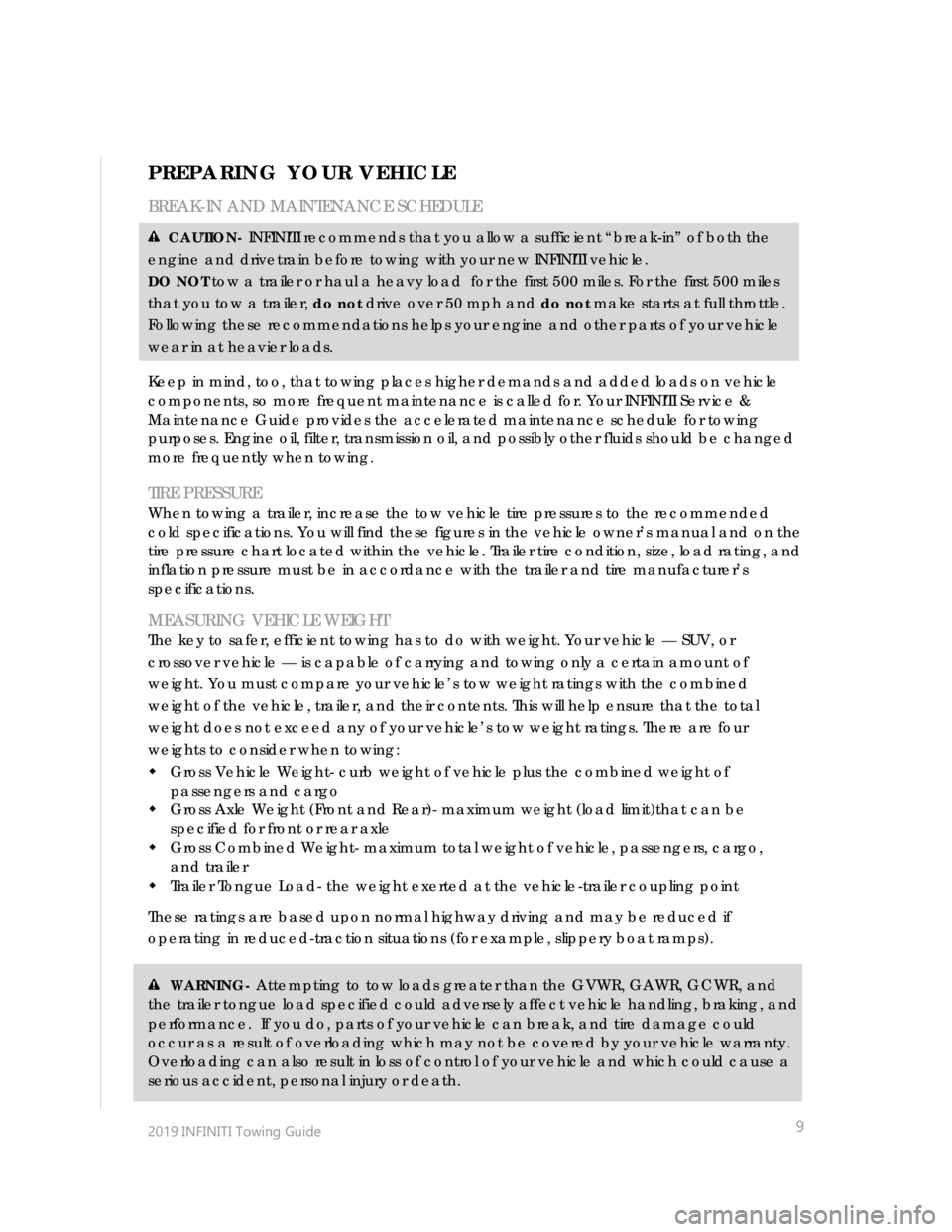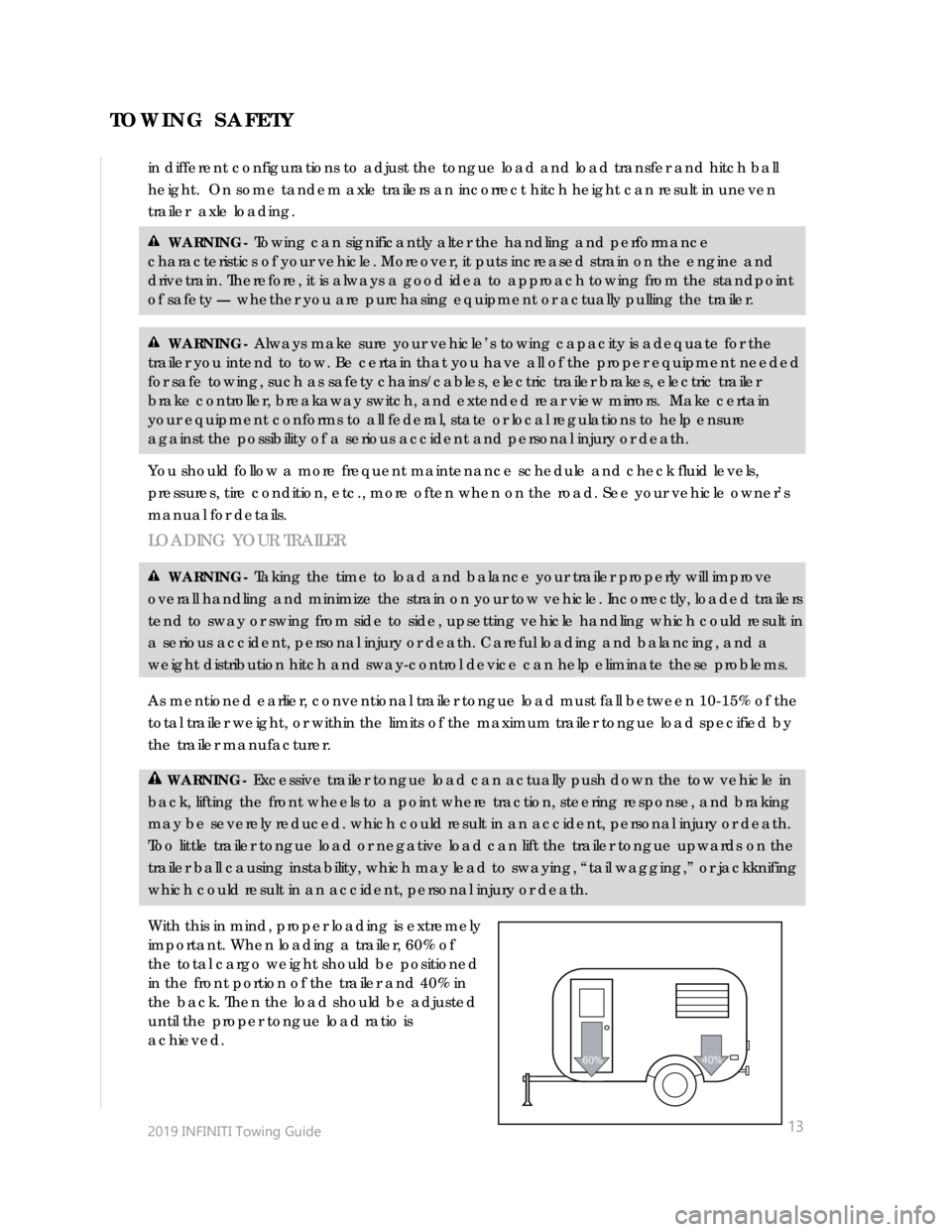traction control INFINITI Q70 2019 Towing Guide
[x] Cancel search | Manufacturer: INFINITI, Model Year: 2019, Model line: Q70, Model: INFINITI Q70 2019Pages: 25, PDF Size: 0.38 MB
Page 10 of 25

2019 INFINITI Towing Guide
9
PREPARING YOUR VEHICLE
BREAK-IN AND MAINTENANCE SCHEDULE
CAUTION- INFINITI recommends that you allow a sufficient “break-in” of both the
engine and drivetrain before towing with your new INFINITI vehicle.
DO NOT tow a trailer or haul a heavy load for the first 500 miles. For the first 500 miles
that you tow a trailer, do not drive over 50 mph and do not make starts at full throttle.
Following these recommendations helps your engine and other parts of your vehicle
wear in at heavier loads.
Keep in mind, too, that towing places higher demands and added loads on vehicle
components, so more frequent maintenance is called for. Your INFINITI Service &
Maintenance Guide provides the accelerated maintenance schedule for towing
purposes. Engine oil, filter, transmission oil, and possibly other fluids should be changed
more frequently when towing.
TIRE PRESSURE
When towing a trailer, increase the tow vehicle tire pressures to the recommended
cold specifications. You will find these figures in the vehicle owner’s manual and on the
tire pressure chart located within the vehicle. Trailer tire condition, size, load rating, and
inflation pressure must be in accordance with the trailer and tire manufacturer’s
specifications.
MEASURING VEHICLE WEIGHT
The key to safer, efficient towing has to do with weight. Your vehicle — SUV, or
crossover vehicle — is capable of carrying and towing only a certain amount of
weight. You must compare your vehicle’s tow weight ratings with the combined
weight of the vehicle, trailer, and their contents. This will help ensure that the total
weight does not exceed any of your vehicle’s tow weight ratings. There are four
weights to consider when towing:
Gross Vehicle Weight- curb weight of vehicle plus the combined weight of
passengers and cargo
Gross Axle Weight (Front and Rear)- maximum weight (load limit)that can be
specified for front or rear axle
Gross Combined Weight- maximum total weight of vehicle, passengers, cargo,
and trailer
Trailer Tongue Load- the weight exerted at the vehicle-trailer coupling point
These ratings are based upon normal highway driving and may be reduced if
operating in reduced-traction situations (for example, slippery boat ramps).
WARNING- Attempting to tow loads greater than the GVWR, GAWR, GCWR, and
the trailer tongue load specified could adversely affect vehicle handling, braking, and
performance. If you do, parts of your vehicle can break, and tire damage could
occur as a result of overloading which may not be covered by your vehicle warranty.
Overloading can also result in loss of control of your vehicle and which could cause a
serious accident, personal injury or death.
Page 14 of 25

2019 INFINITI Towing Guide
13
in different configurations to adjust the tongue load and load transfer and hitch ball
height. On some tandem axle trailers an incorrect hitch height can result in uneven
trailer axle loading.
WARNING- Towing can significantly alter the handling and performance
characteristics of your vehicle. Moreover, it puts increased strain on the engine and
drivetrain. Therefore, it is always a good idea to approach towing from the standpoint
of safety — whether you are purchasing equipment or actually pulling the trailer.
WARNING- Always make sure your vehicle’s towing capacity is adequate for the
trailer you intend to tow. Be certain that you have all of the proper equipment needed
for safe towing, such as safety chains/cables, electric trailer brakes, electric trailer
brake controller, breakaway switch, and extended rear view mirrors. Make certain
your equipment conforms to all federal, state or local regulations to help ensure
against the possibility of a serious accident and personal injury or death.
You should follow a more frequent maintenance schedule and check fluid levels,
pressures, tire condition, etc., more often when on the road. See your vehicle owner’s
manual for details.
LOADING YOUR TRAILER
WARNING- Taking the time to load and balance your trailer properly will improve
overall handling and minimize the strain on your tow vehicle. Incorrectly, loaded trailers
tend to sway or swing from side to side, upsetting vehicle handling which could result in
a serious accident, personal injury or death. Careful loading and balancing, and a
weight distribution hitch and sway-control device can help eliminate these problems.
As mentioned earlier, conventional trailer tongue load must fall between 10-15% of the
total trailer weight, or within the limits of the maximum trailer tongue load specified by
the trailer manufacturer.
WARNING- Excessive trailer tongue load can actually push down the tow vehicle in
back, lifting the front wheels to a point where traction, steering response, and braking
may be severely reduced. which could result in an accident, personal injury or death.
Too little trailer tongue load or negative load can lift the trailer tongue upwards on the
trailer ball causing instability, which may lead to swaying, “tail wagging,” or jackknifing
which could result in an accident, personal injury or death.
With this in mind, proper loading is extremely
important. When loading a trailer, 60% of
the total cargo weight should be positioned
in the front portion of the trailer and 40% in
the back. Then the load should be adjusted
until the proper tongue load ratio is
achieved.
60%40%
TOWING SAFETY